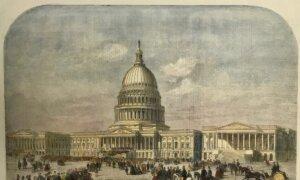Approval of Congress Among Americans Reaches Highest Level in Almost Four Years
The increase in approval ratings for Congress has been fueled primarily by Republican backing, as the GOP now fully controls both the House and Senate.
According to a recent Gallup poll, congressional job approval among Americans has reached its highest level in almost four years, coinciding with President Donald Trump executing an unprecedented number of executive actions across various policy areas, including immigration enforcement and government downsizing.
The poll was conducted from February 3 to 16, shortly after the 119th Congress convened on January 3, marking the first time since 2019 that Republicans have had complete control of both chambers.
Historically, the last time Republican approval of Congress exceeded its current level was in August 2005, when their control of both chambers pushed approval to 57 percent. More recently, during their control of Congress and the White House from 2017 to 2019, the highest recorded approval was 50 percent in February 2017, averaging 29 percent throughout that period.
In contrast, when Democrats held both chambers and the presidency from 2021 to 2023, their approval of Congress peaked at 61 percent in 2021, with an average of 40 percent during that time. A similar pattern was noted from 2009 to 2011 when Democratic control saw party approval for Congress climb to 63 percent in May 2009, collectively averaging 40 percent.
The highest congressional approval ratings for both parties occurred in 2001, following the September 11 terrorist attacks, leading Americans to rally around national institutions. In October 2001, approval ratings reached 89 percent among Republicans, 82 percent among Democrats, and 81 percent among independents.
This poll comes as Senate Republicans are preparing to advance a legislative package centered on Trump’s agenda, which includes his policies on immigration, energy production, and defense.
Trump has called on lawmakers to rally behind the House plan that consolidates major policy initiatives into a single piece of legislation. Meanwhile, House Republicans are concerned that the Senate’s more limited approach may hinder their ability to extend the tax cuts put in place during Trump’s presidency, leading them to favor their own budget bill. The House GOP holds a slim majority at 218-215, putting additional pressure on their legislative strategy.
After a lunch meeting with Vice President JD Vance and Senate Republicans, Thune indicated that the Senate would move forward with its own version of the legislation. “In the end, whether it’s one bill or two bills, we’ll be able to get all of the president’s outlined objectives across the finish line,” Thune stated, adding that a Senate vote is anticipated by Thursday.
Meanwhile, Democrats have pledged to fight against the budget proposal.
The Senate’s proposal outlines a $340 billion budget resolution for fiscal year 2025, increasing annual spending by $85 billion over four years, aimed at funding border security, Trump’s deportation efforts, energy deregulation, and enhanced military spending. Republicans contend that these new expenditures will be balanced by cuts in other areas.
In contrast, the House budget resolution encompasses these same priorities but includes $4.5 trillion in tax cuts, partially offset by $2 trillion in spending reductions and projected economic growth associated with tax and energy policy reforms.
To advance Trump’s legislative agenda efficiently, both chambers must pass an identical budget resolution, allowing Republicans to sidestep Democratic opposition and the Senate filibuster.



